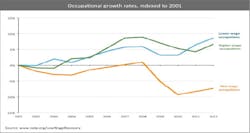Is US Income Inequality Caused by Manufacturing's Relative Decline?
Amidst discussion about the growing gap between top earners and those in the middle and lower income brackets, I've been asked whether I think the U.S. manufacturing industry's relative decline might be a factor. After all, anyone paying the slightest attention to the economy can see that the rise in income inequality and the decline of manufacturing employment occurred during roughly the same years.
Similarly, it doesn't take a genius to observe deteriorating economic opportunities available in cities and towns where manufacturing plants have shut down. As one commentator put it, "Not only has the major industry left town, but the other businesses and even the local identity have suffered."
So when popular IndustryWeek IdeaXchange Xpert Michael Collins submitted a commentary about the increase in income inequality in the U.S., I had to ask him: What's the link to manufacturing? Is there research linking the two?
One chart accompanying his manuscript suggested a link. It illustrated the decline of "mid-wage occupations" jobs, those that pay between $14 and $21 per hour -- which, no doubt, include factory jobs.
In our search for a more explicit link, we found one paper that linked the rise of income inequality to the decline of U.S. manufacturing, both in terms of contribution to GDP and as a percentage of the labor force, along with an increase in the premium of manufacturing compensation versus all other industries, from 11% in 1950 to 23% in 2010. Noting that the Gini coefficient, a measure of inequality, had moved from .379 to .440 (toward increasing inequality) during that time, the author declared: "Together these three trends are the major components of the increasingly palpable trend of income inequality from 1950 to 2010."
However, even for a manufacturing advocate like me, the evidence didn't seem strong enough to support the conclusion -- perhaps because the author references a 2000 U.S. Census Bureau report, which noted a possible link, and then quickly dismissed it. The Census report acknowledged that rising income inequality "began in earnest" in the 1980s, which coincided with "a shift from goods producing industries (that had disproportionally provided high-wage opportunities for low-skilled workers) to technical service industries (that disproportionally employ college graduates) and low-wage industries, such as the retail trade."
But it then concluded: "But within-industry shifts in labor demand away from the less-educated workers are, perhaps, a more important explanation of eroding wages than the shift out of manufacturing."
The report then listed other factors that may have caused the downward trend in wages of less-educated workers.
...it's time to acknowledge that manufacturing is the bedrock of a healthy national economy.
Still other researchers hinted at a link, but hadn't specifically researched manufacturing. One reviewed the relationship between weakening union "power and density" and growing inequality. Several others noted that rising inequality coincided with the divergence between productivity and typical (hourly) workers' pay.
Meanwhile, Jan Berg-Andreassen, chief economist, International Infrastructure & Transport Group LLC, agreed to review the data for IndustryWeek. For his analysis, he compared manufacturing value added as percent of U.S. GDP with the Gini coefficient during five periods in U.S. history.
He concludes: "There is a close adverse relationship between the rise and fall of the manufacturing sector and the income distribution of the U.S."
As a nation, we've spent decades conducting a grand economic experiment testing theories that encourage decisions -- by public policy and business leaders -- that transition the U.S. economy away from manufacturing (read: factory) work. Now it's becoming increasingly evident something is wrong with our economy. Berg-Andreassen's analysis strongly suggests what it is.
Some may want to do further analysis, but I think we'll find that it's time to acknowledge that manufacturing is the bedrock of a healthy national economy. We should be making public policy and business decisions accordingly.





